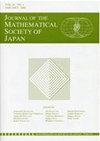Varieties of minimal rational tangents of unbendable rational curves subordinate to contact structures
IF 0.7
4区 数学
Q2 MATHEMATICS
引用次数: 2
Abstract
A nonsingular rational curve $C$ in a complex manifold $X$ whose normal bundle is isomorphic to $${\mathcal O}_{{\mathbb P}^1}(1)^{\oplus p} \oplus {\mathcal O}_{{\mathbb P}^1}^{\oplus q}$$ for some nonnegative integers $p$ and $q$ is called an unbendable rational curve on $X$. Associated with it is the variety of minimal rational tangents (VMRT) at a point $x \in C,$ which is the germ of submanifolds ${\mathcal C}^C_x \subset {\mathbb P} T_x X$ consisting of tangent directions of small deformations of $C$ fixing $x$. Assuming that there exists a distribution $D \subset TX$ such that all small deformations of $C$ are tangent to $D$, one asks what kind of submanifolds of projective space can be realized as the VMRT ${\mathcal C}^C_x \subset {\mathbb P} D_x$. When $D \subset TX$ is a contact distribution, a well-known necessary condition is that ${\mathcal C}_x^C$ should be Legendrian with respect to the induced contact structure on ${\mathbb P} D_x$. We prove that this is also a sufficient condition: we construct a complex manifold $X$ with a contact structure $D \subset TX$ and an unbendable rational curve $C \subset X$ such that all small deformations of $C$ are tangent to $D$ and the VMRT ${\mathcal C}^C_x \subset {\mathbb P} D_x$ at some point $x\in C$ is projectively isomorphic to an arbitrarily given Legendrian submanifold. Our construction uses the geometry of contact lines on the Heisenberg group and a technical ingredient is the symplectic geometry of distributions the study of which has originated from geometric control theory.接触结构下不可展有理曲线的最小有理切线的多样性
对于某些非负整数$p$和$q$,复流形$X$中法线束同构于$${\mathcal O}_{{\mathbb P}^1}(1)^{\oplus p} \oplus {\mathcal O}_{{\mathbb P}^1}^{\oplus q}$$的非奇异有理曲线$C$在$X$上称为不可弯曲有理曲线。与之相关的是点$x \in C,$处的最小有理切线(VMRT)的变化,这是子流形${\mathcal C}^C_x \subset {\mathbb P} T_x X$的起源,由$C$固定$x$的小变形的切线方向组成。假设存在一个分布$D \subset TX$,使得$C$的所有小变形都与$D$相切,人们会问投影空间的哪种子流形可以被实现为VMRT ${\mathcal C}^C_x \subset {\mathbb P} D_x$。当$D \subset TX$是接触分布时,一个众所周知的必要条件是${\mathcal C}_x^C$对于${\mathbb P} D_x$上的诱导接触结构应该是勒让德式的。我们证明了这也是一个充分条件:我们构造了一个具有接触结构$D \subset TX$和不可弯曲的理性曲线$C \subset X$的复流形$X$,使得$C$的所有小变形都与$D$相切,并且VMRT ${\mathcal C}^C_x \subset {\mathbb P} D_x$在某些点$x\in C$与任意给定的Legendrian子流形投影同构。我们的构造使用了海森堡群上的接触线几何,一个技术成分是分布的辛几何,它的研究起源于几何控制理论。
本文章由计算机程序翻译,如有差异,请以英文原文为准。
求助全文
约1分钟内获得全文
求助全文
来源期刊
CiteScore
1.40
自引率
0.00%
发文量
56
审稿时长
>12 weeks
期刊介绍:
The Journal of the Mathematical Society of Japan (JMSJ) was founded in 1948 and is published quarterly by the Mathematical Society of Japan (MSJ). It covers a wide range of pure mathematics. To maintain high standards, research articles in the journal are selected by the editorial board with the aid of distinguished international referees. Electronic access to the articles is offered through Project Euclid and J-STAGE. We provide free access to back issues three years after publication (available also at Online Index).

 求助内容:
求助内容: 应助结果提醒方式:
应助结果提醒方式:


